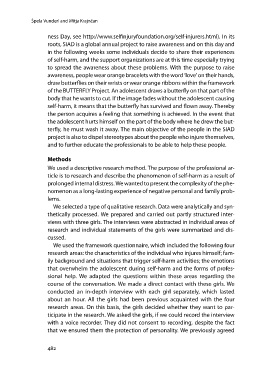Page 482 - Štemberger Tina, Čotar Konrad Sonja, Rutar Sonja, Žakelj Amalija. Ur. 2022. Oblikovanje inovativnih učnih okolij. Koper: Založba Univerze na Primorskem
P. 482
ela Vunderl and Mitja Krajnčan
ness Day, see http://www.selfinjuryfoundation.org/self-injurers.html). In its
roots, SIAD is a global annual project to raise awareness and on this day and
in the following weeks some individuals decide to share their experiences
of self-harm, and the support organizations are at this time especially trying
to spread the awareness about these problems. With the purpose to raise
awareness, people wear orange bracelets with the word ‘love’ on their hands,
draw butterflies on their wrists or wear orange ribbons within the framework
of the BUTTERFLY Project. An adolescent draws a butterfly on that part of the
body that he wants to cut. If the image fades without the adolescent causing
self-harm, it means that the butterfly has survived and flown away. Thereby
the person acquires a feeling that something is achieved. In the event that
the adolescent hurts himself on the part of the body where he drew the but-
terfly, he must wash it away. The main objective of the people in the SIAD
project is also to dispel stereotypes about the people who injure themselves,
and to further educate the professionals to be able to help these people.
Methods
We used a descriptive research method. The purpose of the professional ar-
ticle is to research and describe the phenomenon of self-harm as a result of
prolonged internal distress. We wanted to present the complexity of the phe-
nomenon as a long-lasting experience of negative personal and family prob-
lems.
We selected a type of qualitative research. Data were analytically and syn-
thetically processed. We prepared and carried out partly structured inter-
views with three girls. The interviews were abstracted in individual areas of
research and individual statements of the girls were summarized and dis-
cussed.
We used the framework questionnaire, which included the following four
research areas: the characteristics of the individual who injures himself; fam-
ily background and situations that trigger self-harm activities; the emotions
that overwhelm the adolescent during self-harm and the forms of profes-
sional help. We adapted the questions within these areas regarding the
course of the conversation. We made a direct contact with these girls. We
conducted an in-depth interview with each girl separately, which lasted
about an hour. All the girls had been previous acquainted with the four
research areas. On this basis, the girls decided whether they want to par-
ticipate in the research. We asked the girls, if we could record the interview
with a voice recorder. They did not consent to recording, despite the fact
that we ensured them the protection of personality. We previously agreed
482
ness Day, see http://www.selfinjuryfoundation.org/self-injurers.html). In its
roots, SIAD is a global annual project to raise awareness and on this day and
in the following weeks some individuals decide to share their experiences
of self-harm, and the support organizations are at this time especially trying
to spread the awareness about these problems. With the purpose to raise
awareness, people wear orange bracelets with the word ‘love’ on their hands,
draw butterflies on their wrists or wear orange ribbons within the framework
of the BUTTERFLY Project. An adolescent draws a butterfly on that part of the
body that he wants to cut. If the image fades without the adolescent causing
self-harm, it means that the butterfly has survived and flown away. Thereby
the person acquires a feeling that something is achieved. In the event that
the adolescent hurts himself on the part of the body where he drew the but-
terfly, he must wash it away. The main objective of the people in the SIAD
project is also to dispel stereotypes about the people who injure themselves,
and to further educate the professionals to be able to help these people.
Methods
We used a descriptive research method. The purpose of the professional ar-
ticle is to research and describe the phenomenon of self-harm as a result of
prolonged internal distress. We wanted to present the complexity of the phe-
nomenon as a long-lasting experience of negative personal and family prob-
lems.
We selected a type of qualitative research. Data were analytically and syn-
thetically processed. We prepared and carried out partly structured inter-
views with three girls. The interviews were abstracted in individual areas of
research and individual statements of the girls were summarized and dis-
cussed.
We used the framework questionnaire, which included the following four
research areas: the characteristics of the individual who injures himself; fam-
ily background and situations that trigger self-harm activities; the emotions
that overwhelm the adolescent during self-harm and the forms of profes-
sional help. We adapted the questions within these areas regarding the
course of the conversation. We made a direct contact with these girls. We
conducted an in-depth interview with each girl separately, which lasted
about an hour. All the girls had been previous acquainted with the four
research areas. On this basis, the girls decided whether they want to par-
ticipate in the research. We asked the girls, if we could record the interview
with a voice recorder. They did not consent to recording, despite the fact
that we ensured them the protection of personality. We previously agreed
482


